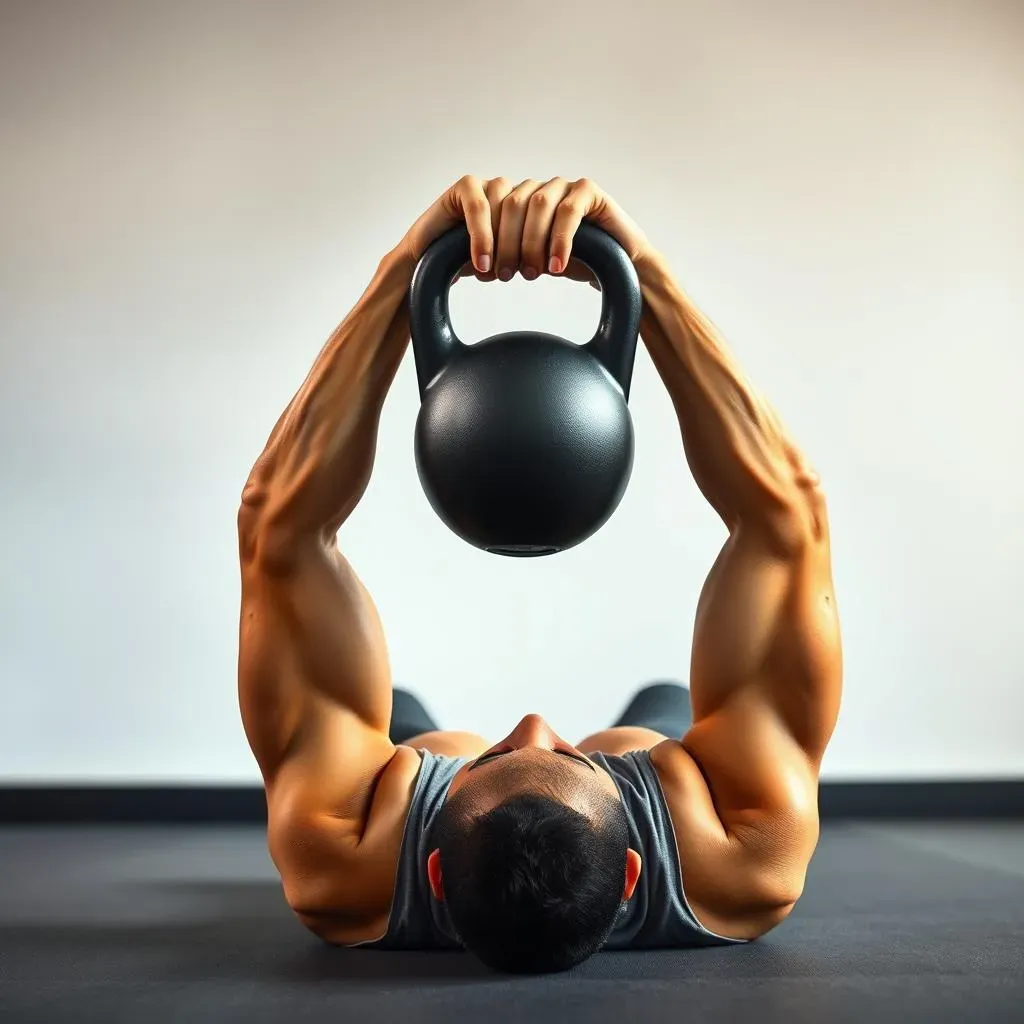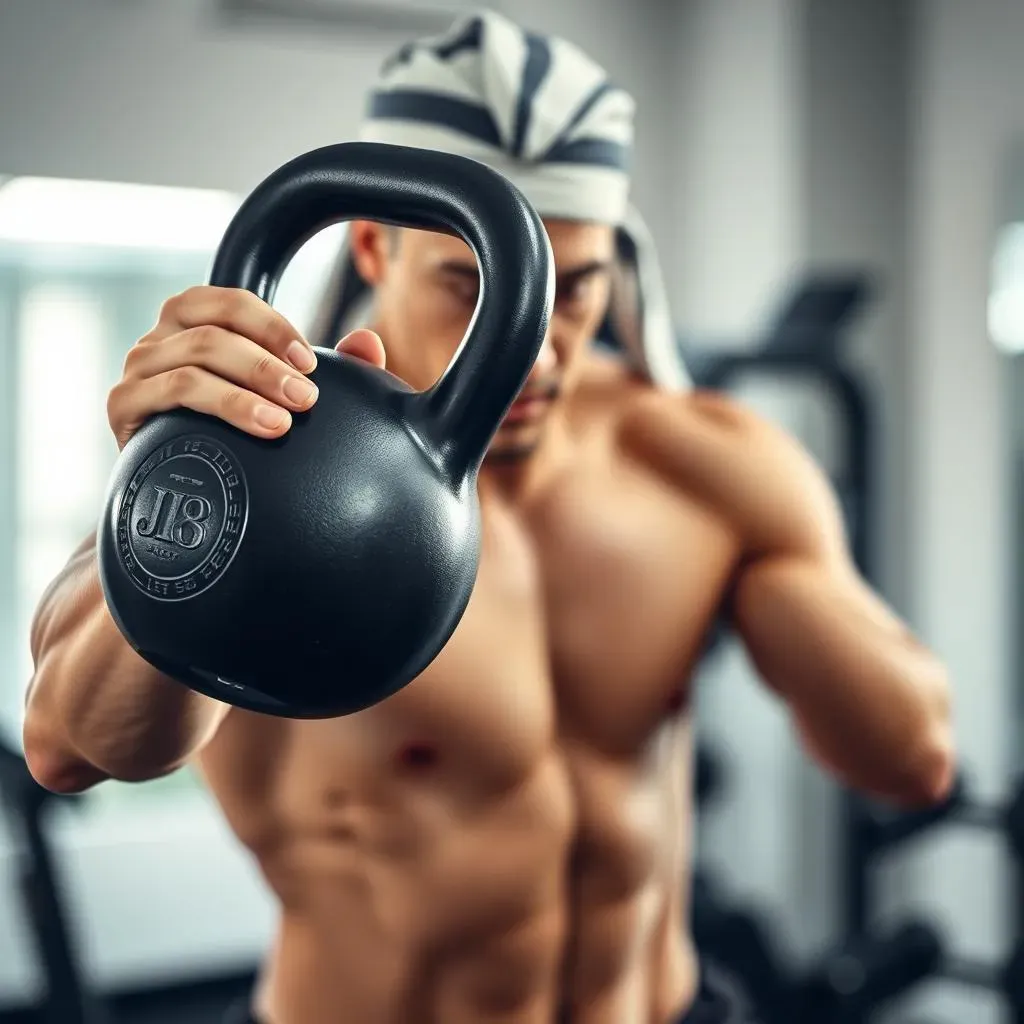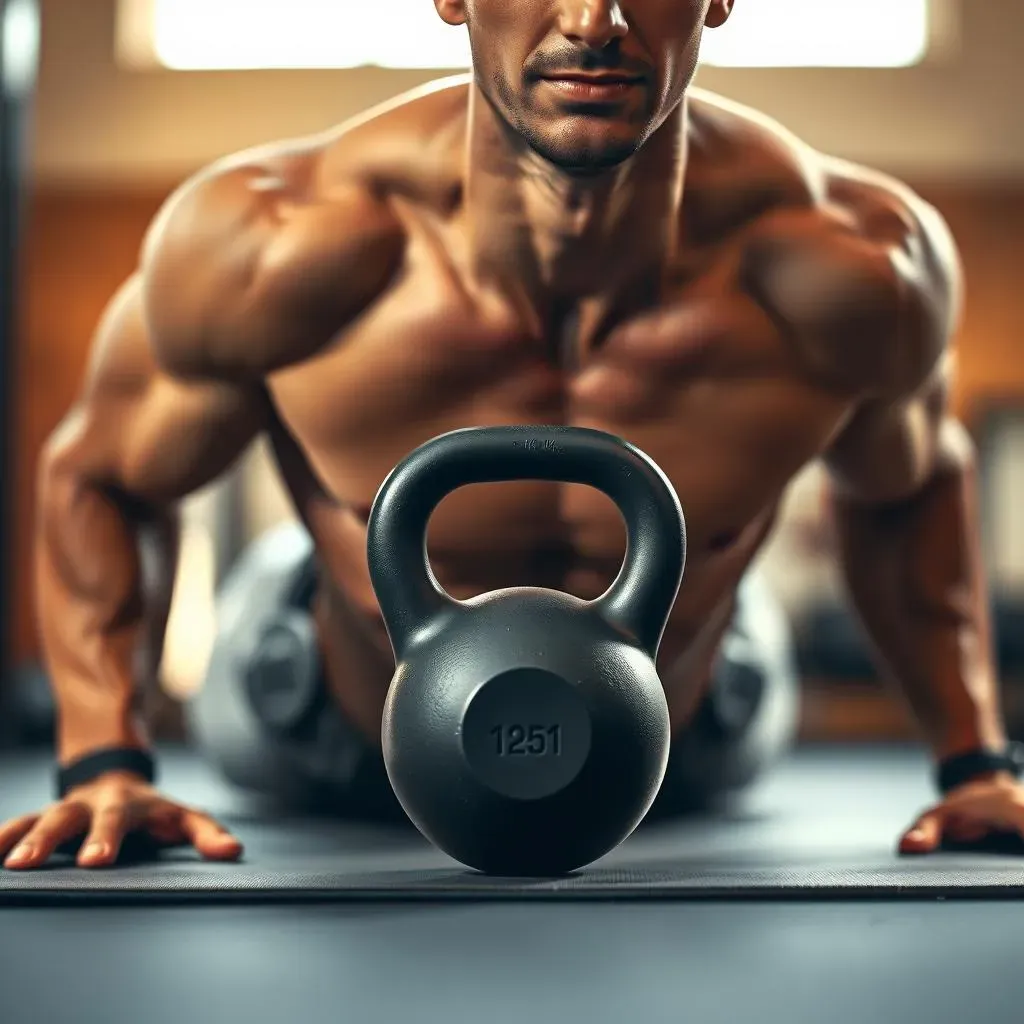Table of Contents
Ever looked at a kettlebell and wondered if it could actually sculpt your chest? I know I have. Forget the bench press for a minute. We're diving into the world of the "chest workout with one kettlebell," proving you don't need a fancy gym to build serious muscle. This isn't about some complicated routine. It’s about using a single, versatile tool to target your pecs in a way that’s both effective and, dare I say, fun. In this article, we'll explore the ins and outs of chest training with just one kettlebell. I'll break down the key muscle groups involved, then we will jump into a series of powerful exercises that you can do anywhere. We will also talk about how to get the most out of each rep, and we'll discuss how to structure your workouts for maximum results. Get ready to discover how a single kettlebell can be your secret weapon for a stronger, more defined chest, no matter your fitness level.
Understanding Your Chest Muscles

Understanding Your Chest Muscles
The Pectoralis Major: Your Main Muscle
So, you wanna know what's going on under the surface when you're working your chest? Let’s talk about the pectoralis major, that’s the big guy. It's the fan-shaped muscle that covers most of your chest. This muscle has a big job, it helps with all kinds of movement, like pushing things away from you, bringing your arms across your body, and even rotating your arms a bit. Think of it like the engine behind every push-up or chest press you do. It’s not just one chunk of muscle, though. The pectoralis major has different parts, or "heads," that do slightly different things, and working all of them is key for a well-rounded chest workout.
When you're doing a chest workout with one kettlebell, you're really putting this muscle to the test. It is important to understand what it does, how it works, so you can focus on engaging it correctly.
The Pectoralis Minor: The Supporting Act
Now, let's not forget the pectoralis minor. It's smaller and sits underneath the pectoralis major. Don't underestimate this little guy. It plays a big role in shoulder movement and stability, working alongside the major muscle to help with things like pulling your shoulder blades together. It might not be the star of the show, but it’s essential for keeping your shoulders healthy and functioning properly. When you train your chest, you're engaging both the major and minor pecs, and that’s why it is important to have a good understanding of them.
It's like having a great supporting actor in a movie; they make the leading actor look even better.
Muscle | Function | Importance in Chest Workouts |
|---|---|---|
Pectoralis Major | Adduction, flexion, and internal rotation of the arm | Primary mover in chest exercises, responsible for size and strength |
Pectoralis Minor | Stabilizes and depresses the scapula | Supports shoulder movement and stability, crucial for overall chest function |
Why Understanding Matters
Why should you bother knowing all this anatomy stuff? Because understanding how your chest muscles work will help you get the most out of your workouts. It's not just about lifting a weight; it's about engaging the right muscles at the right time. When you know the different roles of the pectoralis major and minor, you can better target them with specific exercises. That means you'll see better results, and you'll reduce your risk of injury. So, don't just mindlessly lift, think about what's happening inside your body. It makes a big difference.
I mean, would you try to fix a car without knowing what the engine does? Same logic here, my friend.
Effective Kettlebell Chest Exercises

Effective Kettlebell Chest Exercises
Kettlebell Floor Press: Your Go-To Move
so you've got your kettlebell and you're ready to get started? Let's start with the floor press. It's a classic for a reason. You're going to lie on your back, knees bent, feet flat on the floor. Hold the kettlebell in one hand, with your elbow bent at about a 45-degree angle to your body. Now, push the kettlebell straight up towards the ceiling, focusing on squeezing your chest muscles as you go. Slowly lower the kettlebell back down. This exercise is great because it hits your entire chest, and because you’re on the floor, it’s really stable, so you can focus on good form. Remember, it's not about how much you lift, it's about how well you lift.
I once saw a guy in the gym trying to floor press with a kettlebell that was way too heavy for him, he was shaking so much that he almost dropped it on his face, don't be that guy. Start with a weight you can control.
Seesaw Press: Adding a Little Challenge
Now that you are comfortable with the floor press, let's spice things up with the seesaw press. This is where you use two kettlebells, one in each hand, but we're going to do it with just one for now. Lie on your back as with the floor press, but this time, we will press one side up and bring it down, and then press the other side. It’s like you’re making a seesaw motion with your arms. This exercise will not only work your chest, but also your core, since you’re trying to balance the weight and keep your body stable.
It’s like a secret combo move that's gonna give you a great workout while building strength and stability.
"The journey of a thousand miles begins with a single step... or a single kettlebell press." - Some wise fitness dude
Decline Floor Press: Hitting the Lower Chest
You know, we can’t forget the lower chest. The decline floor press is a sneaky way to get at that area. For this one, you'll elevate your feet on something stable like a box or bench. This slight decline changes the angle of the press, and that will make your lower chest work a little bit harder. It’s the same motion as the regular floor press, but with a twist. Remember to keep your core tight, and your body in a straight line. It's a subtle shift, but it makes a big difference.
It’s like you are turning up the volume on your lower chest muscles.
Exercise | Target Area | Key Points |
|---|---|---|
Kettlebell Floor Press | Overall Chest | Keep elbow at 45 degrees, controlled movement |
Seesaw Press | Chest and Core | Alternating sides, maintain balance |
Decline Floor Press | Lower Chest | Elevated feet, straight body line |
How to Build Muscle with a Single Kettlebell

How to Build Muscle with a Single Kettlebell
Progressive Overload: The Key to Growth
Alright, so you're doing your kettlebell chest presses, and you're feeling good. But how do you actually build muscle? It's all about something called progressive overload. This fancy term just means you need to gradually increase the challenge over time. It’s like leveling up in a video game. You wouldn't expect to beat the final boss right away, would you? Same thing with your muscles. They need to be challenged more and more to grow. This could mean increasing the weight, doing more reps, or even shortening your rest periods. Don’t get me wrong, it is not about going from 0 to 100 in one week, it's about a steady and consistent increase in the difficulty of your workout.
I remember when I first started, I could barely do 5 reps with a 20 pound kettlebell, now I can do 15 with a 40 pound one, and I'm still trying to improve. It is a marathon, not a sprint.
Time Under Tension: Making Every Rep Count
Another thing that is very important is the time your muscles are under tension. It's not just about how many reps you do, but how long your muscles are working during each rep. Instead of just quickly going through the motion, try to control the movement, especially the lowering portion of the exercise. This will increase the time your muscles are under tension, which is a key factor for muscle growth. Imagine that you're squeezing a sponge, you wouldn't want to squeeze it quickly and let go, you would want to squeeze it slowly, and hold it tight for a few seconds, same thing with your muscles.
So, slow down, focus on the squeeze, and make each rep count, your muscles will thank you later.
Principle | Description | How to Apply |
|---|---|---|
Progressive Overload | Gradually increasing the challenge over time | Increase weight, reps, sets, or decrease rest periods |
Time Under Tension | The duration muscles are under stress during a rep | Control the movement, especially the eccentric phase (lowering) |
Rep Schemes for Different Goals
Now, let's get a little more specific about reps. Depending on what you’re going for, the number of reps you do will change. If you're trying to build power, think about doing 1-3 reps, with a heavier weight. If you want to build strength, then 4-6 reps is a great range. And if your goal is hypertrophy, which means building muscle size, then you are looking for 8-20 reps. It is important to find the range that is perfect for you. Don’t be afraid to play with the numbers to see what works best for your body.
I usually do a mix of all of them, because why not? It's like having a full toolbox with all the tools you need.
Proper Form: The Foundation of Progress
Last but not least, let's talk about form. It doesn’t matter how much weight you lift, if your form is bad, you will not get any benefit. Proper form will not only help you get the most out of each exercise, but it will also prevent injury. It's better to do fewer reps with good form than more reps with bad form. Before increasing the weight, take your time to practice the movement, and feel the muscles working. If you are unsure about your form, don’t be afraid to ask a friend or a personal trainer to help you out.
Remember, it's not a race, it's about building a solid foundation for long-term results.
Goal | Rep Range | Weight |
|---|---|---|
Power | 1-3 | Heavy |
Strength | 4-6 | Moderate to Heavy |
Hypertrophy | 8-20 | Moderate |
Optimizing Your Kettlebell Chest Workout

Optimizing Your Kettlebell Chest Workout
Train Chest From All Angles
So, you're getting the hang of the basic kettlebell chest exercises, that’s awesome! But you know, just doing the same movements over and over won't cut it in the long run. To really build a well-rounded chest, you’ve gotta hit it from all angles. Think about your chest muscles like a map, you have the upper chest, the lower chest, and the middle part. You need to make sure you’re not skipping any location. It's a lot like building a house, you can’t just focus on one wall, you have to build all of them to make it strong and stable.
For example, the decline floor press is great for the lower chest, while the regular floor press targets the middle. By mixing them in your workout, you’re making sure every part of your chest is getting the attention it deserves.
The Power of Unilateral Training
Now, let's talk about something that can really boost your chest workout: unilateral training. What does that even mean? It means working one side of your body at a time. When you do a kettlebell floor press, you’re usually using one arm at a time, and that's exactly what we want. This method is great because it helps identify and correct any strength imbalances you might have. It’s like you have a weaker side that you did not know about, and unilateral training will make it stronger.
It also engages your core more, as your body works harder to stabilize itself during the movement. I've seen people who were surprised at how much stronger their non-dominant side got after they started doing this.
"The body achieves what the mind believes." - Napoleon Hill
Training Aspect | Description | Benefit |
|---|---|---|
Training from all angles | Targeting different parts of the chest | Ensures balanced muscle development |
Unilateral Training | Working one side of the body at a time | Corrects imbalances, improves core stability |
Don't Forget the Rest and Recovery
so you're hitting the gym hard, that's great, but let's be real, you can't just go hard all the time. Your muscles need time to recover and rebuild. You need to listen to your body and give it the rest it needs. Think of it like charging your phone, you can't use it all the time without charging it back up. So, make sure you have enough sleep, eat a healthy diet, and do not overtrain.
I usually take a week off every 8-12 weeks to let my body fully recover, and I suggest you do the same. It’s not about being lazy; it's about being smart and strategic.
Wrapping Up Your Kettlebell Chest Journey
So, there you have it – a complete guide to building a powerful chest with just one kettlebell. We've covered the anatomy, the best exercises, and the key techniques to make every rep count. Remember, consistency is your best friend here. It's not about lifting the heaviest weight, but about proper form, progressive overload, and listening to your body. Don't be afraid to experiment with different exercises and rep ranges to find what works best for you. And always, always prioritize rest and recovery. Whether you’re a beginner or a seasoned lifter, incorporating these kettlebell movements into your routine will help you achieve the chest you've always wanted. So grab that kettlebell and let's get to work.